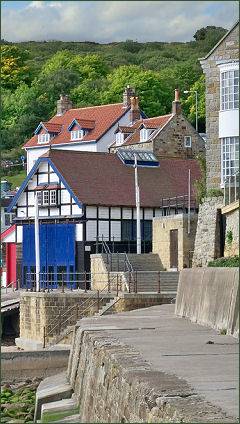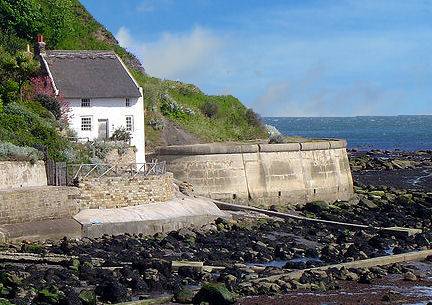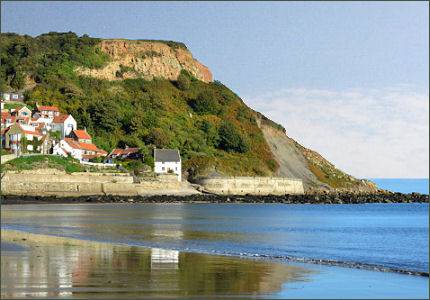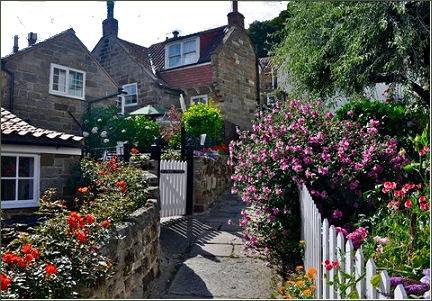Runswick Bay
OS grid reference:- NZ 817 164
 The delightful old fishing village of Runswick Bay on the beautiful Heritage Coast area of the North York Moors National Park boasts much charm.The village is situated 8 miles to the north of the town of Whitby.
The delightful old fishing village of Runswick Bay on the beautiful Heritage Coast area of the North York Moors National Park boasts much charm.The village is situated 8 miles to the north of the town of Whitby.
 The village's red-roofed cottages huddle on the northern end of a sweeping bay facing the North Sea. It has a mile long sandy beach and is very popular with holidaymakers.
The village's red-roofed cottages huddle on the northern end of a sweeping bay facing the North Sea. It has a mile long sandy beach and is very popular with holidaymakers.
Runswick Bay has a peaceful sandy beach which is sheltered from the northern gales by Lingrow Knowle, the lofty crag which towers above the bay.
Fossils abound on the beach, ammonites particularly are locked into the small scattered ironstone pebbles. Brachiopods, marine animals similar to clams can also be found. The fossil remains of a Plesiosaurus, esitmated to be 180 million years old and an Ichthyosaurus, a large predator which was similar to a dolphin in shape, were found here a century ago and are now on display at Whitby Museum.
Runswick Bay has a charming thatched coastguard's cottage, which is probably the most photographed building in the village, three pubs, a café and a campsite. The Runswick Bay Hotel offers cask ales and homemade Yorkshire pub food and accommodation.
Many cottages have been lost to the sea over the centuries. Though the village is now protected by a sea-wall, the rate of erosion can be determined from the row of beach huts on the cliff to the south of the village. About 150 years ago, the whole village, with the exception of one house, sunk down in one night towards the margin of the sea; though fortunately no lives were lost.
The RNLI lifeboat station in the village was in use until the late 1970's. The Runswick Bay Rescue Boat (RBRB) was formed in 1982 after the main RNLI station moved further up the coast to Staithes. The local lifeboat is still actively supported. On one occasion, the women of the village launched and crewed the boat, to rescue their menfolk who had been caught offshore in a violent squall.
In the cliffs of Runswick Bay there are small caves called Hob Holes, formed by the action of the waves, and completely submerged at high tide. A hob is a creature from the folklore of the north of England. Hob Holes is reputed to be the haunt of a goblin, Hob. This hob was said to be unusual in that it was thought to be able to cure whooping cough, local parents would bring their afflicted child to the cave and recite a rhyme in the hope of a cure.


Paths from the village lead both North and South on the Cleveland Way, a long distance footpath which runs for 110 miles (177 km) from Helmsley to the Brigg at Filey, skirting the North York Moors National Park.
Towns and Villages of Yorkshire
